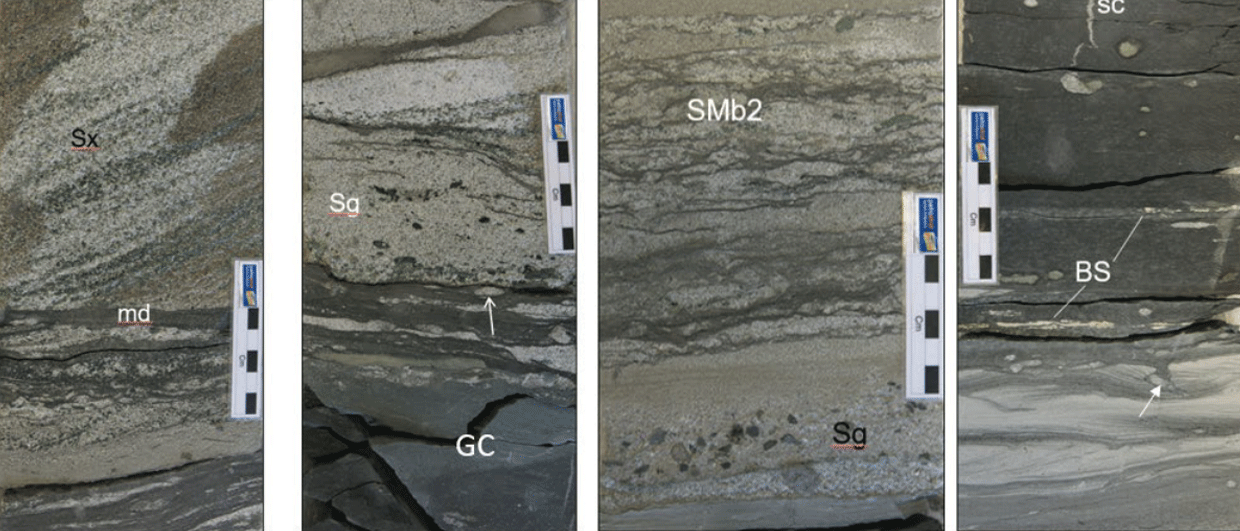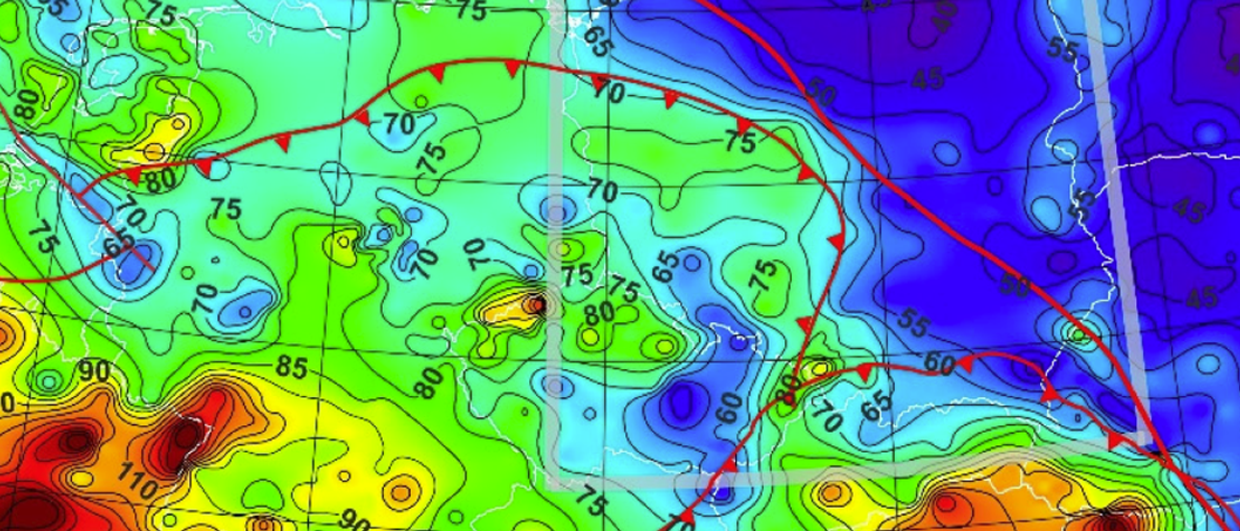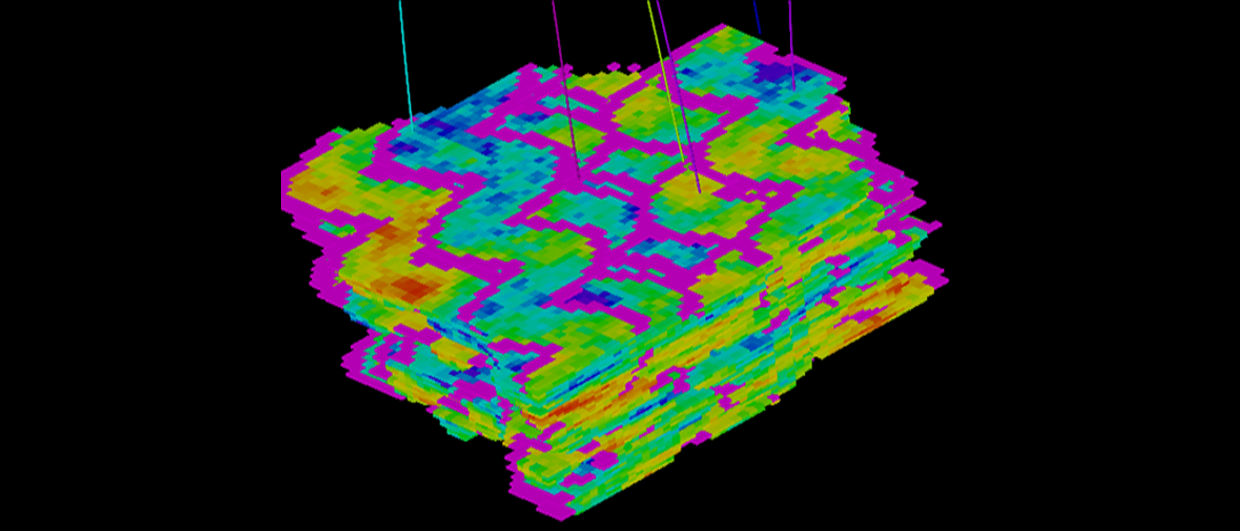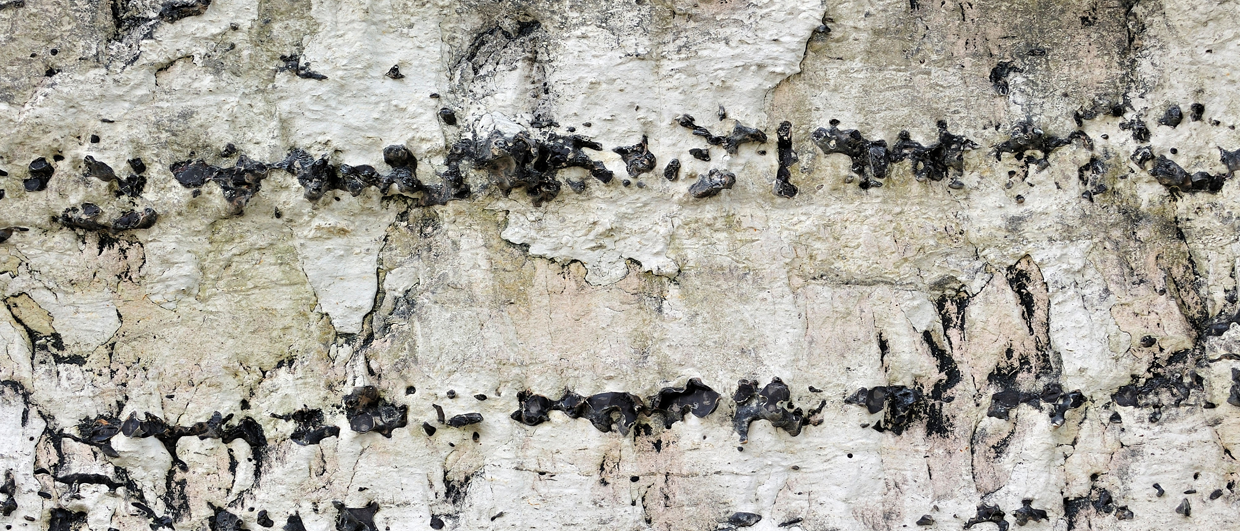Up to 60% of the world’s conventional petroleum is reservoired in carbonate rocks – but they are often regarded with apprehension by the industry.
Despite their reputation, carbonate reservoirs are often no more ‘difficult’ than their siliciclastic counterparts – but they are very different, and require an alternative knowledge base in order to effectively find, interpret and characterise them. The main challenges in developing carbonate reservoirs result from their often heterogeneous nature, which undermines our ability to predict reservoir quality, particularly at interwell scales, and to overcome often low recovery factors. Since carbonate reservoirs host a major proportion of the Earth’s remaining conventional petroleum resources, it is clearly crucial that we fully understand them.
A prograding Lower Cretaceous carbonate platform, Vercors, France. Studies of field outcrops such as this can guide us towards building more realistic models of carbonate reservoir architectures. Source: Claude Alleva/Pixabay.
Variations in carbonate reservoir stratigraphy, diagenesis and rock-fabric all influence development costs and ultimate recovery and so have significant economic impact. While progress has been made on both stratigraphic and pore-scale aspects of carbonate reservoir characterisation over the last few decades, major hurdles still exist with respect to understanding and dealing with the uncertainties that derive from carbonate reservoir heterogeneity. New technologies and workflows based around petrophysics and digital modelling are helping provide solutions, but we still need to increase our understanding of the composition, diagenesis and depositional origins of carbonates.
Complex depositional facies mosaics on Australia’s Great Barrier Reef; environmental variability is responsible for much of the heterogeneity seen in carbonate reservoirs. Very few modern carbonate depositional systems can match the scale of the extensive carbonate platforms of the past. Source: Gaby Stein/Pixabay.
Diverse Hydrocarbon Reservoir Types
For many in the industry, a typical list of petroleum reservoir types might include:
deepwater,
fluvial,
paralic (deltaic),
shallow marine,
aeolian,
lacustrine – and ‘carbonates’.
While a clear distinction is generally made between the different siliciclastic depositional systems, it seems there is little recognition of the equal diversity of carbonate depositional systems.
Each carbonate depositional system has its own distinctive architecture and reservoir quality distribution resulting from the nature of its organic (or inorganic) ‘factory‘ and stratigraphic and diagenetic context. These differences are not immediately obvious, in the way that a desert sediment is clearly different from a deep marine fan. A more realistic range of carbonate reservoirs should therefore cover environments such as mounds, isolated build-ups, shoals, reefs of various kinds, shelf, pelagic muds and lakes, and also include diagenetically highly modified rocks such as dolomites, evaporites, and karst terrains.
Recognising this diversity is not only a key aspect of locating carbonate reservoirs during exploration, but also of carbonate reservoir description. This understanding, sometimes guided by outcrop studies, ultimately allows the construction of realistic static reservoir frameworks populated with facies and rock types, which leads in turn to the optimal placement of development wells.
There are many parallels between the architectures of siliciclastic depositional systems from similar environments through geological time; were this not the case, our ability to interpret ancient siliciclastic depositional systems would be very different. While carbonate platforms also show superficially similar geometries through time, the detailed internal facies characteristics, early mineralogy, and subsequently diagenesis between platforms of different ages can be markedly different, not least because the constructing organisms have periodically changed. Prediction of this in a petroleum geology context requires specialist stratigraphic knowledge.
Carbonate Reservoir Issues
There are some features unique to carbonate reservoirs that materially affect their development and commerciality, but remain challenging to resolve.
One issue is rock-typing, a categorisation of reservoir rocks into dynamic ‘bins’, generally derived from studies of depositional and diagenetic textures and other measured physical parameters. Most current carbonate rock-typing methods unfortunately include an inbuilt, uncontrolled upscaling process. For example, a single thin section from a routine poroperm core plug is often used to identify the rock type for a much larger volume – yet several petrographic rock types can often be found in close proximity within a carbonate core sample, particularly in vuggy or bioturbated lithologies. Further complications arise from the fact that many carbonate successions consist of vertically heterogeneous but laterally persistent layers.
In addition, friable or vuggy carbonates can seldom be effectively sampled using conventional plugs, or may not even be recovered in core, so the geologist may completely overlook such lithologies, particularly as they often have no unique wireline log characters. Such rocks, which are potentially problematic in a development context, are then even less likely to be identified in uncored wells. Yet friable, porous lithologies are also often the most permeable, so small, plug-scale samples clearly often do not represent the porosity, permeability and potential of coarser carbonate rocks.
Pore systems in carbonate rocks can vary widely, with diverse, complex pore shapes and sizes and a high probability of multimodal pore-size distribution within a single sample. This often leads to large ranges in permeability, even for a single rock type, something which makes estimation of dynamic behaviour challenging. Particular problems are encountered when trying to extrapolate rock types from cores to uncored wells using wireline logs, or later in history-matching reservoir performance. Determining the relationship between the micro- and macro-pore networks in a carbonate reservoir is thus critical and requires detailed understanding of microporosity generation, its distribution, and its role in fluid flow. Important in an exploration context, loss of porosity with depth is less well quantified in carbonate rocks than in siliciclastic rocks. It is interesting to note, however, that dolomites are often structurally more competent than limestones and their resistance to chemical compaction means that they may retain porosity more effectively at depth.
Thin sections of two very different carbonate reservoirs which illustrate pore-scale heterogeneity: (A) a leached bioclastic grainstone with mostly mouldic porosity; (B) an oolitic grainstone with intergranular porosity and microporosity within the grains. Field of view in both about 5 mm.
Thin sections of two very different carbonate reservoirs which illustrate pore-scale heterogeneity: (A) a leached bioclastic grainstone with mostly mouldic porosity; (B) an oolitic grainstone with intergranular porosity and microporosity within the grains. Field of view in both about 5 mm.
Permeability prediction is a major issue in carbonate reservoir characterisation. The variable pore systems can frequently lead to dual permeability properties which may facilitate rapid breakthrough of injection fluids (e.g. water or gas) or ‘low-resistivity pay’, most markedly where there are connected vugs. Poor lateral but good vertical spatial correlation in reservoir permeability, often obscured by wide well spacing, also complicates the characterisation and development of many carbonate reservoirs. Geoscientists thus need to understand in some detail how permeability distribution can be tied to stratigraphy, structural evolution and diagenetic processes within reservoir architectures.
Fractures can play a crucial role in carbonate reservoir performance, so an understanding of their distribution and dynamic behaviour over time is essential. Moreover, faults which juxtapose carbonate against carbonate seldom effectively seal, so that intra-reservoir faults are more likely to act as conduits in carbonate than in siliciclastic reservoirs, making exploration for fault-sealed traps less attractive in carbonate-dominated fairways, unless a reservoir abutting a known seal can be clearly identified on seismic. As they grow, carbonate platform margins can become steep and unstable, leading to the development of syn-sedimentary faults and fractures, particularly where compaction occurs over softer slope and basinal sediments. Permeable faults and fractures also strongly influence burial dissolution and other diagenetic processes like dolomitisation.
Photomicrographs of dolomites from two reservoirs. Porosity in both is mostly intercrystalline (oil stained in sample A) but the sample B has retained some original texture as moulds after bioclasts. Field of view in both about 5 mm.
Photomicrographs of dolomites from two reservoirs. Porosity in both is mostly intercrystalline (oil stained in sample A) but the sample B has retained some original texture as moulds after bioclasts. Field of view in both about 5 mm.
All these factors must be considered when characterising a carbonate reservoir, whilst maintaining an awareness of the distinctive carbonate stratigraphic architectures that control the distribution of these features.
Fractures and Stylolites
These are often perceived as playing a significant role in carbonate reservoir performance, but the dynamic impact of both is difficult to quantify without expensive in-reservoir tests. Moreover, where the well stock consists predominantly of vertical wells, dynamically important fractures and faults may not be effectively sampled, increasing uncertainty around fracture permeability.
The mechanical stratigraphies of carbonate successions can be markedly different from those of siliciclastic successions, and this influences fracture distribution; massive reefal or early-cemented platform margins have no counterparts in siliciclastic environments, for example. In other settings, interbedded lithologies create numerous permutations of mechanical layering, such as thin-bedded limestones with shaly partings or inter-bedded limestones and dolomites. These are distributed, often cyclically, within stratigraphic frameworks with changing bed thicknesses and styles and can strongly influence fracture density, distribution and character. Shales that facilitate bedding-parallel shear are abundant in siliciclastic successions, but are rare in carbonate ones. However, evaporite intercalations occur within some arid carbonate platform interior successions and may influence fracture distribution in a similar fashion.
In carbonate reservoirs the effects of fractures can be difficult to distinguish from those of thin high-permeability layers or of conduits that originate through karst dissolution beneath major sequence boundaries. Extremely heterogeneous reservoirs like these are among the most problematic of all to characterise, develop and manage, regardless of matrix reservoir quality, not least because it is difficult to isolate the dynamic impact of any single feature; if there is one area in which carbonate reservoirs can be said to be more ‘difficult’ than siliciclastic reservoirs, it is here.
Progress Made
It is important to distinguish between reservoir issues that can be addressed through improving our knowledge of the geology of carbonate rocks, and those that represent reservoir problems which can be overcome through the application of generic tools and technologies to allow better physical resolution or imaging. In the latter context, improvements in computational technologies, reservoir modelling and simulation methods, as well as ‘smart-well’ technologies, can mitigate the dynamic impacts of the heterogeneities typical of carbonate reservoirs. Improvements in seismic resolution and attribute analysis are goals for the geophysical community with an ultimate (but possibly unrealistic?) prize of in situ measurement of reservoir porosity and permeability and real-time imaging of flood fronts.
Poroperm heterogeneity in carbonate reservoirs is due to many factors, but one major contributor is subaerial exposure during sea-level lowstands, leading to leaching and karstification illustrated here in the Bahamas. Source: Crazya88/Dreamstime.com.
Major advances are being made towards a better understanding of carbonate diagenesis, many aspects of which, such as dolomitisation, have remained enigmatic for decades. Modelling that can account for the fluid and chemical fluxes responsible for various carbonate diagenetic processes may provide greater insight into the ways in which carbonate rocks transform during burial. A combination of new technologies with petroleum systems modelling can provide a route towards a better understanding of carbonate diagenesis on a regional scale.
On the positive side, the relationship between carbonate sediments and antecedent structural topography and their variations with time and relative sea level are now well enough understood, so that, in an exploration context, generating maps of gross depositional environments is no longer a major issue, providing there is access to good data. The routine application of sequence and seismic stratigraphic principles allows us to interpret the detailed evolution of carbonate platforms on seismic and to develop new plays with meaningful depositional environments and conceptual reservoir potential.
However, predicting reservoir quality for carbonate plays remains as large a problem as it ever was, particularly in underexplored basins. Discoveries in the South Atlantic of unexpectedly large, excellent pre-salt oil reservoirs in unusual lacustrine facies have shown just how limiting preconceptions or complacency in such matters can be.
The study of carbonate geology remains challenging but fascinating, and enthusiastic carbonate geologists will always be needed in oil and gas. Without a doubt, the geologists who are best able to provide knowledgeable input to the exploration for and development of carbonate reservoirs are those who have a first-hand, in-depth understanding of the rocks, and this can only be achieved by taking every opportunity to experience them, in core, in thin-section and in the field.
Reference:
Burchette T., 2012. Carbonate rocks and petroleum reservoirs: A geological perspective from industry. In: Garland J., Nielsen J.E., Laubach S.E., Whidden K.J. (eds) Advances in Carbonate Exploration and Reservoir Analysis. Geological Society, London, Special Publication, 370, 17–37.
Further Reading on Carbonate Hydrocarbon Reservoirs / Carbonate Petroleum Geology
Carbonate Geology of The Florida Keys
Jane Whaley
The picturesque Florida Keys are not just a favourite holiday destination, they also offer geoscientists a masterclass on carbonate geology and the sedimentary processes associated with creating carbonate reservoirs.
This article appeared in Vol. 15, No. 6 – 2019
The Pre-Salt Hydrocarbon Reservoirs of the South Atlantic
Paul Wright, Carbonate Geoscience
There are wide lessons to be learned from the controversy over the origins of the enigmatic Cretaceous lacustrine carbonate reservoirs of offshore Brazil.
This article appeared in Vol. 16, No. 4 – 2019
Carbonate Hydrocarbon Reservoirs
Thomas Smith
The 2006 discovery at Tupi, offshore Brazil, opened up a new chapter for petroleum reservoirs: lacustrine carbonates capable of producing hydrocarbons at extremely high rates.
This article appeared in Vol. 15, No. 4 – 2018





